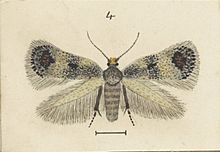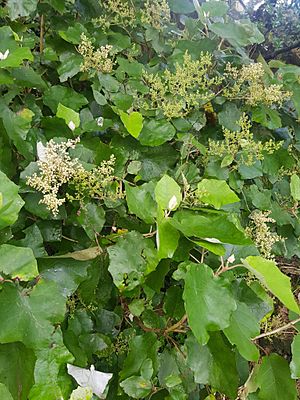Stigmella cypracma facts for kids
Quick facts for kids Stigmella cypracma |
|
|---|---|
 |
|
| Male | |
| Scientific classification | |
| Kingdom: | |
| Phylum: | |
| Class: | |
| Order: | |
| Family: |
Nepticulidae
|
| Genus: |
Stigmella
|
| Species: |
S. cypracma
|
| Binomial name | |
| Stigmella cypracma (Meyrick, 1916)
|
|
| Synonyms | |
|
|
Stigmella cypracma is a tiny moth that lives only in New Zealand. It belongs to a family of moths called Nepticulidae. These moths are special because their young, called larvae, are "leaf miners." This means they live and eat inside the leaves of plants.
The larvae of this moth make their cocoons inside the leaves too. The main plant they eat is called Brachyglottis repanda. Adult moths fly around in February, and from September to November.
Contents
How Scientists Name This Moth
Scientists give every living thing a special name. This helps everyone know exactly which creature they are talking about.
This moth was first described by a scientist named Edward Meyrick in 1916. He used a specimen collected by George Hudson in Karori. Meyrick first named it Nepticula cypracma.
Later, in 1919, Meyrick thought he had found a new species and named it Nepticula perissopa. But it turned out to be the same moth! In 1989, other scientists, Hans Donner and Christopher Wilkinson, officially said that Stigmella perissopa was the same as Stigmella cypracma.
The original specimen used to describe the moth, called a holotype, is kept safe at the Natural History Museum, London.
What Stigmella cypracma Looks Like
The larvae of S. cypracma are small, about 4 millimeters long. They are a pale green color.
The adult moth is also quite small. It has a whitish-yellow head and dark grey body. Its front wings are a grey-whitish color with dark grey speckles. The base of the wing is dark purple-grey, and there's a shiny, coppery-bronze spot near the tip. The back wings are grey.
You can tell S. cypracma apart from similar moths like S. ogygia and S. hakekeae because its wings are wider and have a more even color.
Where Stigmella cypracma Lives
This moth is found only in New Zealand. It has been found in several places, including Northland, Bay of Plenty, Taranaki, Whanganui, and Havelock.
Life Cycle and Habits
The larvae of Stigmella cypracma are active from May to October and also in December. They are leaf miners, which means they tunnel and eat inside the leaves of their host plant.
The tunnels they make are narrow and winding. They don't follow a straight line. Sometimes, their tunnels create brown patches on the leaf as the plant tissue withers. The tunnel usually ends in a wider, blotch-like area. The waste from the larvae, called frass, is left in one or two rows in the middle of the tunnel.
What's really interesting is that these larvae make their cocoons inside the leaf too! They spin a brown silk cocoon right within their leaf mine. This is quite rare, as S. cypracma is one of only two moth species in New Zealand that pupate inside their leaf mines. Cocoons with live pupae have been found in May, June, August, September, and December.
Adult moths are seen flying in February and from September to November. This suggests that there are two generations of these moths each year.
Host Plant
The larvae of Stigmella cypracma feed on the leaves of the plant called Brachyglottis repanda.


